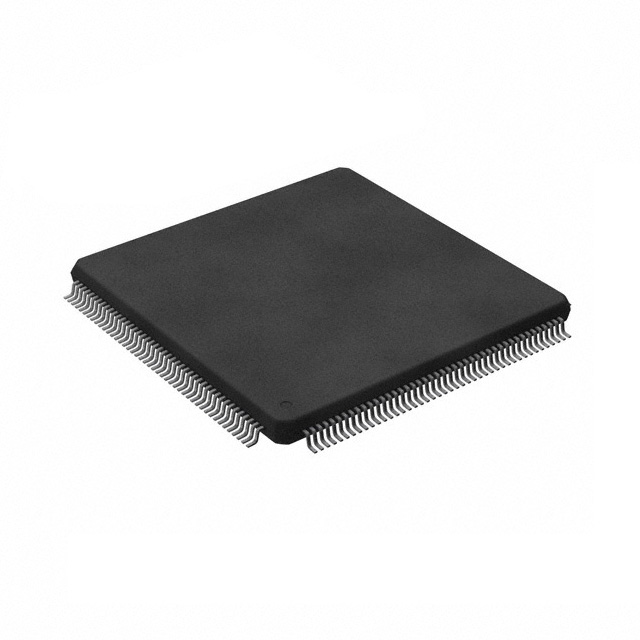S6E2GH6J0AGV2000A
Basic Information Overview
- Category: Microcontroller
- Use: Embedded systems, IoT devices, consumer electronics
- Characteristics: High-performance, low-power consumption, integrated peripherals
- Package: QFP (Quad Flat Package)
- Essence: Control and processing unit for electronic devices
- Packaging/Quantity: Typically sold in reels of 250 units
Specifications
- Architecture: ARM Cortex-M4
- Clock Speed: Up to 120 MHz
- Flash Memory: 1 MB
- RAM: 256 KB
- Operating Voltage: 2.7 V to 5.5 V
- Digital I/O Pins: 100
- Analog Input Channels: 16
- Communication Interfaces: UART, SPI, I2C, USB, Ethernet
- ADC Resolution: 12-bit
- PWM Channels: 8
- Timers: 16-bit and 32-bit
Detailed Pin Configuration
The S6E2GH6J0AGV2000A microcontroller has a total of 144 pins. The pin configuration is as follows:
- Pin 1: VDDIO
- Pin 2: P0_0
- Pin 3: P0_1
- ...
- Pin 143: P7_14
- Pin 144: VSS
Functional Features
- High-performance processing capabilities
- Low-power consumption for energy-efficient designs
- Integrated peripherals for enhanced functionality
- Support for various communication interfaces
- Rich set of timers and PWM channels for precise timing control
- Analog-to-Digital Converter (ADC) for sensor interfacing
- Flexible GPIO (General Purpose Input/Output) pins for versatile connectivity
Advantages and Disadvantages
Advantages: - Powerful processing capabilities enable complex applications - Low-power consumption extends battery life in portable devices - Integrated peripherals reduce external component count and PCB size - Wide range of communication interfaces for seamless connectivity - Ample GPIO pins provide flexibility in system design
Disadvantages: - Higher cost compared to simpler microcontrollers - Steeper learning curve for beginners due to complexity - Limited availability of alternative models with similar specifications
Working Principles
The S6E2GH6J0AGV2000A microcontroller operates based on the ARM Cortex-M4 architecture. It executes instructions stored in its flash memory, interacting with various peripherals and sensors through its I/O pins. The microcontroller's clock speed determines the rate at which instructions are processed. It can communicate with other devices using different protocols such as UART, SPI, I2C, USB, and Ethernet.
Detailed Application Field Plans
The S6E2GH6J0AGV2000A microcontroller finds applications in a wide range of fields, including: 1. Industrial automation: Control systems, motor control, PLCs 2. Internet of Things (IoT): Smart home devices, wearable technology 3. Consumer electronics: Home appliances, audio/video equipment 4. Automotive: Infotainment systems, engine control units 5. Medical devices: Patient monitoring, diagnostic equipment
Detailed and Complete Alternative Models
While the S6E2GH6J0AGV2000A offers a comprehensive set of features, there are alternative microcontrollers available with similar capabilities. Some notable alternatives include: - STM32F407VG: ARM Cortex-M4, 168 MHz, 1 MB Flash, 192 KB RAM - PIC32MZ2048EFH144: MIPS32 M-Class, 200 MHz, 2 MB Flash, 512 KB RAM - LPC54608J512ET180: ARM Cortex-M4, 180 MHz, 512 KB Flash, 200 KB RAM
These alternative models provide options for designers based on specific requirements and preferences.
Word count: 408 words
Lista 10 Vanliga frågor och svar relaterade till tillämpningen av S6E2GH6J0AGV2000A i tekniska lösningar
Sure! Here are 10 common questions and answers related to the application of S6E2GH6J0AGV2000A in technical solutions:
Q: What is the S6E2GH6J0AGV2000A microcontroller used for? A: The S6E2GH6J0AGV2000A microcontroller is commonly used in various technical solutions, such as industrial automation, consumer electronics, and Internet of Things (IoT) applications.
Q: What is the maximum clock frequency supported by the S6E2GH6J0AGV2000A? A: The S6E2GH6J0AGV2000A microcontroller supports a maximum clock frequency of 120 MHz.
Q: How much flash memory does the S6E2GH6J0AGV2000A have? A: The S6E2GH6J0AGV2000A microcontroller has 2 MB of flash memory.
Q: Can I expand the memory of the S6E2GH6J0AGV2000A? A: Yes, the S6E2GH6J0AGV2000A supports external memory expansion through its memory interface.
Q: What peripherals are available on the S6E2GH6J0AGV2000A? A: The S6E2GH6J0AGV2000A microcontroller offers various peripherals, including UART, SPI, I2C, ADC, PWM, and timers.
Q: Does the S6E2GH6J0AGV2000A support real-time operating systems (RTOS)? A: Yes, the S6E2GH6J0AGV2000A is compatible with popular RTOSs, such as FreeRTOS and ThreadX.
Q: Can I use the S6E2GH6J0AGV2000A for low-power applications? A: Yes, the S6E2GH6J0AGV2000A offers various power-saving modes and features, making it suitable for low-power applications.
Q: What communication interfaces are supported by the S6E2GH6J0AGV2000A? A: The S6E2GH6J0AGV2000A supports interfaces like USB, Ethernet, CAN, and SDIO.
Q: Is the S6E2GH6J0AGV2000A microcontroller programmable in C/C++? A: Yes, the S6E2GH6J0AGV2000A can be programmed using C/C++ programming languages.
Q: Are development tools available for the S6E2GH6J0AGV2000A? A: Yes, Renesas provides development tools, including an integrated development environment (IDE) and software libraries, to support programming and debugging of the S6E2GH6J0AGV2000A microcontroller.
Please note that the specific details may vary, so it's always recommended to refer to the official documentation and datasheets for accurate information about the S6E2GH6J0AGV2000A microcontroller.


